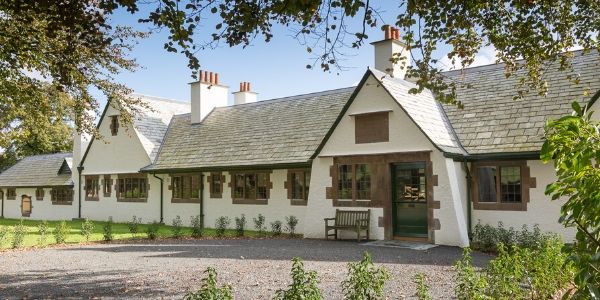I’ve been thinking a lot about nurturing buildings while working on Winsford Cottage Hospital. Landmark revives and cares for its buildings, of course - but buildings themselves can also be nurturing.
Every new Landmark is unique, yet it usually slots to some extent into an existing theme within our wonderful portfolio. Winsford Cottage Hospital is no exception. In the Middle Ages, sick parishioners as well as monks were cared for beneath the lofty wind-braced timber roof of the 15th- century infirmary in the grounds of Woodspring Priory. And in the early 17th century, the Countess of Cumberland and her daughter Lady Anne Clifford expressed the medieval meaning of the word ‘hospital’ as refuge for the needy in their eccentric circular almshouse, Beamsley Hospital.
But for me, Winsford Cottage is the most nurturing of any Landmark building. It is the only hospital built by the architect C. F .A Voysey (1857-1941), and it is the qualities he gave it that makes it so special.
 Voysey’s characteristic style of architecture is clearly apparent at Winsford Cottage Hospital.
Voysey’s characteristic style of architecture is clearly apparent at Winsford Cottage Hospital.
Winsford was built 1899-1900, at Halwill Junction, the formerly the junction between the old London & South Western Railway line from Waterloo to Bude and the one to Launceston. It was built by Maria Medley as a philanthropic memorial to her late husband George, to serve the deserving poor of thirteen parishes in North Devon.
 Voysey designed the plaque on which Maria Medley dedicated the hospital to her husband’s memory,
Voysey designed the plaque on which Maria Medley dedicated the hospital to her husband’s memory,
In 1914 the Hospital was requisitioned as a convalescent home for soldiers from the trenches during the Great War. When peace returned, a sequence of characterful GPs steered the hospital through another three decades of service as a trust hospital. Then, in 1948, came the creation of the NHS. The thick walls of Winsford shrugged, and adapted seamlessly to these changes of tenure, the peace found within them continuing to heal the sick, its floor plan and fabric continuing to function as Voysey so meticulously conceived them to do.  ‘The hall should receive its guests with composure and dignity, but still with brightness, open arms, and warmth’. - Voysey
‘The hall should receive its guests with composure and dignity, but still with brightness, open arms, and warmth’. - Voysey
Best known for his country houses for the affluent middle class, Voysey was an architect to whom the nurturing principal mattered in all his buildings. He regarded every client as ‘a precious thing, to be protected from all violent intrusion’, and applied this no less in his designs for the Winsford patients than those for his wealthy private clients.
He developed his signature style of design very early in his career, every detail carefully considered to instil a sense of calm repose, deconstructing and reconstituting familiar elements of traditional cottage architecture.
Voysey’s buildings all have steeply pitched roofs with dramatic eaves lines and thick walls, expressing shelter. Windows are set in strong horizontal lines (‘it is pleasant to feel well protected when the weather is disturbed and angry,’ he wrote, ‘so you will not give me great sheets of plate glass’). Inside, the ceilings are low and the characteristic white and green (‘that most restful of colours’) of a Voysey exterior is carried through the interiors.
 Rooms of deep shelter.
Rooms of deep shelter.
It would not surprise me if J. R. R. Tolkein was unconsciously inspired by Voysey’s houses – their occasional circular windows, their stooping eaves - when he imagined the cosy hobbits’ houses at Hobbiton in his Lord of the Rings trilogy. Winsford shares their qualities of deep shelter, the rooms leading off the long spine corridor almost burrow-like, looking out onto sheltering trees. Sometimes, an architect’s works come to express the spirit of the age in a way that permeates the wider imagination.
In 1915, Rifleman Gilmour of the London Regiment was convalescing at Winsford after being shot in the leg on his very first visit to the trenches. He painted a little watercolour of Winsford Cottage Hospital, Red Cross flag flying outside, and titled it ‘My Little Grey Home in the West’ after a popular music hall song of the day adapted by the tommies.
 Rifleman Gilmour’s painting of the hospital in 1915.
Rifleman Gilmour’s painting of the hospital in 1915.
'When the golden sun sinks in the hills
And the toil of the long day is o’er,
Though the road may be long,
In the lilt of a song,
I forget I was weary before.
Far ahead where the blue shadows fall,
I shall come to contentment and rest,
And the toils of the day,
Will be all charmed away
In my little grey home in the west.'
In one sense, it is of course a tragedy that rising maintenance and health costs meant that Winsford Cottage Hospital could no longer survive in its original purpose, and slipped too far into dilapidation. But our restoration includes community and treatment rooms in one wing, so that it continues to serve the community Maria Medley so wanted to help. And it’s a very happy thought that hundreds of Landmarkers will now also find refreshment and ease within the walls of this, the most nurturing of all Voysey’s buildings.